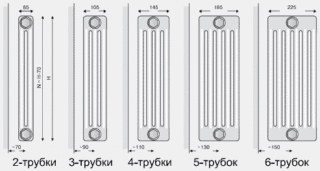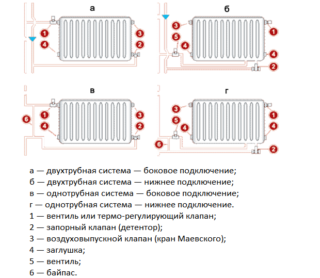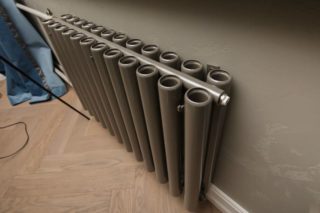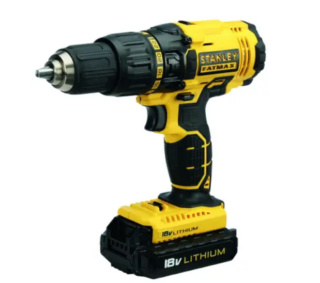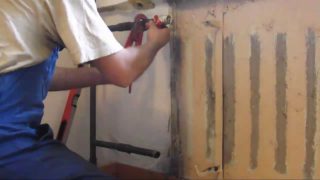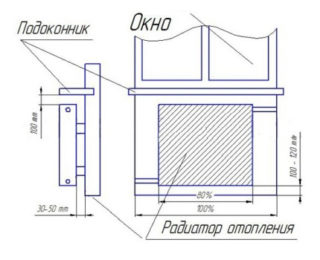The comfort of a home depends on many factors: the availability of a constant and stable electricity network, cold and hot water supply, as well as high-quality heating. The heating of private houses and apartments can be carried out using various types of batteries. Heating elements for liquid systems include tubular radiators. They have their own working characteristics that distinguish them from classic batteries, as well as a number of positive qualities.
Tubular Radiator Design
The main function of radiators, regardless of their type, is to ensure optimal temperature conditions in the room in which they are located. The appearance of tubular products is practically no different from classic batteries. They are a bit thinner and look sleeker.
The design of tubular radiators has the following details:
- upper and lower collectors;
- steel tubes for connecting the collectors to each other;
- fittings for connecting to the heating system.
The number of handsets depends on the type of model. Usually in one section there are from 2 to 60. With an increase in the number of tubes, the depth of the battery increases and its width decreases while maintaining all the heat transfer indicators. The dimension parameter is especially important for rooms with a small area.
All elements are usually made of steel. This material has high rates of strength, ductility, resistance, weldability and corrosion resistance. Cast iron and copper appliances are also represented on the Russian market. All parts are connected to each other by laser welding. This method provides the smallest joint width and high structural strength.
Features of tubular radiators
Products of this kind are characterized by the following features:
- Connectivity variability. Connection to the heat supply system is carried out in a lateral or lower way. This is possible due to the presence of side and bottom fittings.
- Variability of installation. Some models have legs that allow you to mount the battery on the floor without fixing it to the wall.
- Low hydraulic resistance, which provides high throughput.
Depending on the model, the characteristics will vary within the following limits:
- Product height from 150 mm to 3000 mm.
- Radiator width from 200 mm to 2000 mm.
- Depth from 50 mm to 300 mm.
- The wall thickness is 1.2-2 mm.
- Working pressure reaches 10 atm.
- The number of sections, which depends on the width.
- The maximum temperature of the radiator is 110 ° C.
- The number of tubes in the section. Determines the depth.
- Tube section. Most often, products with a round or rectangular cross section are used.
The heat transfer index does not depend on the shape of the tubes. Efficiency depends on the diameter of each tube and their number. The form has a decorative function.
Advantages and disadvantages
Tubular radiators are a relatively new source of heat for suburban homes and apartments. They have a number of positive features that distinguish them from classical heaters:
- Easy installation. Self-installation is possible without the help of a wizard.
- Heating is evenly distributed compared to conventional radiators.
- Safety.
- Long service life. High build quality ensures durability.
- No sharp corners to minimize injuries.
- Ease of maintenance and care.
- A wide range of models. It is possible to select a radiator for a certain interior of a heated room.
Minuses:
- Low heat dissipation. Inherent in low-cost models with a small number of tubes per section.
- Cost. Tubular radiators are more expensive than classic radiators.
- A breakthrough may occur at the weld site in the event of a sharp pressure surge.
- Limiting the area of effective and safe use.
Pressure surges are characteristic of heating systems in apartment buildings. For this reason, experts advise installing tubular radiators in private homes where there is an autonomous heating system.
The performance of radiators
Steel tubular radiators can be made to order. The client can choose the size of the device, its appearance, color, technical specifications and other important parameters.
On sale you can find products of various design designs. Such models are both a heating device and a stylish decorative item. They can be built into furniture, benches, bar counters.
The location of the tubes emit vertical and horizontal radiators. Vertical models are characterized by a height of up to 3 meters and a small width. Tubes are most often also placed vertically in sections. Such tubular bimetallic radiators are actively used in places with limited space - flights of stairs, near balconies, in rooms with stained glass. Horizontal appliances have a small height and a large width. Tubes can be placed horizontally and vertically. Connection to the heating system is made laterally.
Mounting Features
Self-installation of steel pipe radiators is similar to the installation algorithm of classic models. With minimal skills and abilities, even a home master will be able to do it yourself without the help of professionals.
To work, you will need the following tools, which should be in every home:
- screwdriver;
- hammer drill;
- pliers;
- key;
- roulette;
- level;
- a simple pencil.
Instead of a perforator, an impact drill can be used.
The installation algorithm depends on the mounting method - wall or floor. Wall-mounted is considered the most convenient way to install any radiators. In the case of tall models, another method is not acceptable. Fixing is carried out on the wall with special fasteners. When floor mounting, the product is placed on special legs on the floor. A similar method is suitable for mounting wide and low models of tubular steel radiators.
Installation consists of the following steps:
- Removing the old battery. Dismantling must be done carefully so as not to damage the heating system.
- Marking of fasteners and their installation. It is important to choose the right brackets, as steel radiators are heavy. The load for which the clips are designed must be appropriate.
- Radiator canopy on fasteners.
- Assembly kit assembly.
- Installation of cranes and valves.
- Connection to the heating system.
- Crimping.
Next, the assembled system is tested.
Choosing a Connection Method
Tubular batteries are connected in two ways - bottom or side. The choice is influenced by the design of the particular purchased model, the individual characteristics of the pipe layout and the condition of the heat supply system.
In the lower method, the falling and return parts of the pipes are attached to the radiator from below. In the case of lateral connection, the supply pipes and return pipes can be switched on from the left or right side, depending on the features of the product.
Correct Installation Recommendations
Regardless of the type of tubular heating battery and its characteristics, effective functioning can be achieved by following these tips:
- The distance between the upper edge and the window sill for horizontal radiators should be 5-10 cm.
- Between the bottom and the floor should be 9-12 cm.
- The distance from the wall to the radiator should be 2-5 cm. When installing a reflective heat-insulating layer, brackets of increased length will be required.
Steel tubular heating radiators are an effective and safe way to heat rooms and small buildings. A wide selection of shapes and colors allows you to choose a model for any interior, and physical features make it possible to install in rooms with children.
You should buy the product in a professional trusted store. It is also recommended to take devices from well-known Russian or European manufacturers. These include German firms Arbonia and Zehnder, offering excellent quality products. Also popular are Russian Harmony devices manufactured at KZTO (Kirma Thermal Equipment Plant).
When buying, you need to check the integrity of the device, the availability of the necessary documentation, as well as a warranty card.
